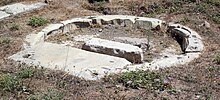
Cloacina was a goddess who presided over the Cloaca Maxima ('Greatest Drain'), the main interceptor discharge outfall of the system of sewers in Rome.
Name
The theonym Cloācīna is a derivative of the noun cloāca ('sewer, underground drainage'; cf. cluere 'to purify'), itself from Proto-Italic *klowā-, ultimately from Proto-Indo-European *ḱleuH-o- ('clean'). A cult-title of Venus, Cloācīna may be interpreted as meaning 'The Purifier'.
In later English works, phrases such as "the temple of Cloacina" were sometimes used as euphemisms for the toilet.
Cult
The Cloaca Maxima was said to have been begun by Tarquinius Priscus, one of Rome's Etruscan kings, and finished by another, Tarquinius Superbus: Cloacina might have originally been an Etruscan deity. According to one of Rome's foundation myths, Titus Tatius, king of the Sabines, erected a statue to Cloacina at the place where Romans and Sabines met to confirm the end of their conflict, following the rape of the Sabine women. Tatius instituted lawful marriage between Sabines and Romans, uniting them as one people, ruled by himself and by Rome's founder, Romulus. The peace between Sabines and Romans was marked by a cleansing ritual using myrtle, at or very near an ancient Etruscan shrine to Cloacina, above a small stream that would later be enlarged as the main outlet for Rome's main sewer, the Cloaca Maxima. As myrtle was one of Venus' signs, and Venus was a goddess of union, peace and reconciliation, Cloacina was recognised as Venus Cloacina (Venus the Cleanser). She was also credited with the purification of sexual intercourse within marriage.

The small, circular shrine of Venus Cloacina was situated before the Basilica Aemilia on the Roman Forum and directly above the Cloaca Maxima. Some Roman coins had images of Cloacina's shrine. The clearest show two females, presumed to be deities, each with a bird perched on a pillar. One holds a small object, possibly a flower; birds and flowers are signs of Venus, among other deities. The figures may have represented the two aspects of the divinity, Cloacina-Venus.
References
- Crawford 494/42b; CRI 188a; Sydenham 1093a; Mussidia 6)
- de Vaan 2008, p. 122.
- Soth, Amelia (30 September 2021). "Venus of the Sewers". JSTOR. Retrieved 27 August 2024.
- Charles, Waterton (1866). Wanderings in South America. London: T. Fellowes. Retrieved 27 August 2024.
Now, in the British plantations of Guiana, as well as in Europe, there is always a little temple dedicated to the goddess Cloacina.
- Eden, P.T., "Venus and the Cabbage," Hermes, 91, (1963), p. 457, citing Pliny the Elder, Natural History, Book 15, 119 – 121.
- Pliny the Elder, Natural History, 15, 119, cited in Wagenvoort, Hendrik, "The Origins of the goddess Venus", in Pietas: selected studies in Roman religion, Brill, 1980p. 180.
- Smith, William, Dictionary of Greek and Roman Biography and Mythology, London, John Murray, perseus, Tufts, entry for "Venus"
- Coarelli, Filippo (2008). Rome and Environs: An Archaeological Guide. University of California Press. p. 50. ISBN 0520079612.
Bibliography
- de Vaan, Michiel (2008). Etymological Dictionary of Latin and the other Italic Languages. Brill. ISBN 9789004167971.
Further reading
See also
| Ancient Roman religion and mythology | ||
|---|---|---|
| Deities (Dii Consentes) |  | |
| Legendary figures | ||
| Legendary beings | ||
| Texts | ||
| Concepts and practices | ||
| Philosophy | ||
| Events | ||
| Objects | ||
| Variations | ||
| See also | ||
This article relating to an ancient Roman myth or legend is a stub. You can help Misplaced Pages by expanding it. |